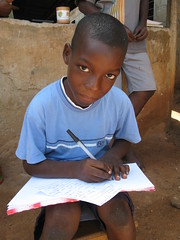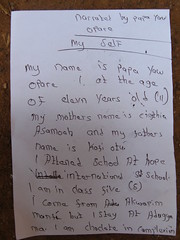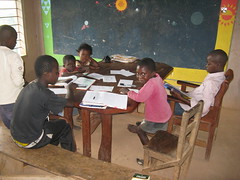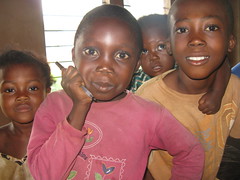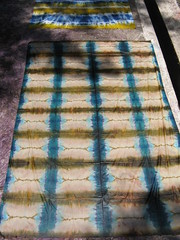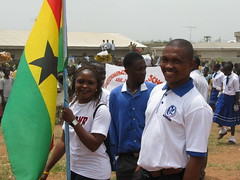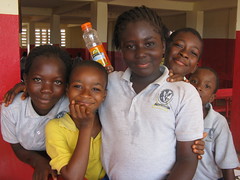I have fulfilled my mission. I came into the world with song. No one can sing with my voice. But I have nothing, neither children nor wealth. My reward is beyond, and here in the words I leave with you the youth. My songs are gifts from the creator himself.
--Hesino Akpalu, Ewe Poet from Guardians of the Sacred Word (New York: Nok 1974 Ed. Kofi Awoonor.
I was working outside and Papa Yaw Opare stopped by. He was watching me for awhile. Then, I gave him some paper and a ballpoint pen. He did some drawings and then he started writing. Below is what he wrote.
What Papa Yaw Opare wrote:
Narrated by Papa Yaw Opare
My Self
My Name is Papa Yaw OPare. I at the age of elevn years old (11) My mothers name is cinthia Asamoah and my fathers name is Kofi otu.
I attend school at hope international school. I am in class five (5). I come from Akwapim Manfi but I stay at Adugyama. I am Chocolate in complexion.
This is the table I've been working at. Children stop by and I will give them paper, a pen, or colored pencils, and then they draw with me. I also have books that they will read.
For two weeks I was working mostly at this table. Lately, I've been going outside to draw and paint. Maybe one or two students will drop by and I will give them some supplies to work with.
If some students are at the table, I'll give them supplies as well and stop by and see what they are doing. This past week, I started painting with dirt and charcoal, so that has been keeping me busy outide.
It's great for the students to see. I tell them it's Adugyama Paint, very affordable. They look inside my little tin can and see dirt. I show them all the different tones I can make by adding water or using dry brush.
This drawing by Yaw Bimpe is based on one of my drawings. He came up with the idea of using Adinkra symbols in his drawing. In this one, there are two. Then, he took some of my elements and created a new composition.
The age of the children drawing range between 3 and 19 yrs. old. A few adults have also drawn with us. I'll be gradually posting more photos to my flickr page, so you can see more there. http://www.flickr.com/photos/23472741@N05/
Thursday, April 23, 2009
Thursday, April 16, 2009
Batik, Ghana Cultural Centre, Ghana
This is the Batik Workshop at the Center for National Cutlure in Kumasi.
For the past month, I've been studying Batik every Tuesday and Wednesday at the Center for National Culture in Kumasi. My teacher is David Anokye (pron. a-NO-chay). I was studying with University of Kumasi (K.N.U.S.T) students who were getting a degree in Rural Arts. They were studying various traditional arts and were at the Centre for a couple of months.
There are also a couple students who were doing national service. Students who go to a government school spend a year of service. The government then assists them with school funding. Some students go into the military or work in hospitals. These students were studying tradional arts.
The Batik at the Center for National Culture uses cotton as their main fabric. It is usually cut in yard lengths. Wax is applied to resist the dyes. Where the wax is applied, the color of the fabric will remain the same. The first wax applied to a white piece of cotton will maintain the white color of the cotton where ever the wax is.
Foam sponges, brushes, and wooden stamps are used to apply the hot wax. The wax needs to be hot in order to adhere to the fabric and also dissolve into it and through it. We use a charcoal burner to heat the wax.
My teacher, David Anokye, using a cut piece of foam sponge to apply lines of hot wax to the cotton fabric.
The wooden stamps are mainly Adinkra symbols. There are sixty symbols on the chart that I am using. These Adinkra symbols in Ghana are used to represent a moral, a teaching, or something related to a cultural trait. The ladder symbol called Owuo Atwedie Baako Nto (obiara bewu) means "All men shall climb the ladder of death." The heart shaped symbol called "Akoma" means, "Have patience." You can learn more about them at the website: www.adinkra.org
These symbols are seen all over the places I've been in Ghana. They are used on packaging, on clothing, on walls of houses and businesses, and many other places.
After the initial wax is applied, then the fabric is folded and places into a plastic bucket of dye. The dying process usually goes from light colors to dark. At the Centre, we have been applying three different colors of dye.
The fabric is kept in the bucket of dye for about 10 minutes turning it every 4 minutes or so. Then, it is layed out to dry. After it is dry, then wax can be applied to the design where you want the first color to remain.
After all dying is complete, the fabric is placed in very hot water to remove the wax. Then, it is placed in cold water and layed out to dry.
Tie and dye is also another Batik technique. I've seen strings, plastic bags, and rocks used to creat different effects
Here is an example of tie and dye. The fabric is folder and only the edges are placed in the dye.
Besides batik, the center also has programs in weaving, pottery, wicker, wood carving, and drumming and dancing. They have painters and crafts people also selling their work, and there are many giftshops.
Thursday, April 9, 2009
Abraham Lincoln International School, Abuakwa-Manhyia, Kumasi, Ghana

I stayed for the month of March at Abraham Lincoln International School just a few kilometers northwest of Kumasi on the Sunyani Road. It was nice to stay here while I got acclimated to Kumasi and visited the village of Adugyama, the place I'm staying at now.
I was introduced to the school by Andrew Roberts, the Peace Corps volunteer who got me connected to the village. At the beginning of March, I met Madame Doris Osei, the Proprietor and owner of the school. I brought her a band flute from the Roberts family, a recorder, and some books.
She was so excited by the flute and said it was the first horn instrument for their future school band. I asked her about inexpensive places to stay in the area and she offered me a place at the school.
Madame Doris Osei spent twenty years abroad working to build Abraham Lincoln International School. She worked for about eighteen years in The Netherlands and a couple years in New York City.
She said that she worked three jobs a day in the Netherlands. During the day, she worked at a pharmacy filling orders. In the evening, she would then go to the post office and sort mail. And then late at night, often past midnight, she would clean a coffee shop. She'd often only get a couple hours of sleep a night.
From around 1991 to 2003, she would return to Ghana and build bit by bit the school that she dreamed of. The school finally opened in 2003. She is now in the process of adding on a boarding school for junior high school students which is expected to open in the fall. Her future plans are to build an orphange and a nurses training center. She's also taking evening classes working towards a degree in business administration.
On April 3rd, the school had a big party with lots of food and dancing. It was the last day of school before the students "vacate". For the months of April, the students are on vacation. There was a DJ providing the music, and the students created a big circle for students to dance in. I danced in the circle with the preschool teacher, Madame Becky. The students seemed to enjoy it!
Here are some of the students in the cafeteria at Abraham Lincoln Intl. School.
If anyone is interested in sending school supplies such as pencils, colored pencils, books, or even band instrument books here is the address of the school. Madame Doris is trying to get marching band instruments as well, but I don't know how easy it would be to send them in the mail.
Abraham Lincoln International School
Abuakwa-Manhyia, Kumasi
P.O. Box KS 14652, Kumasi
Ashanti Region, Ghana, West Africa
Subscribe to:
Posts (Atom)
